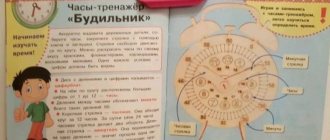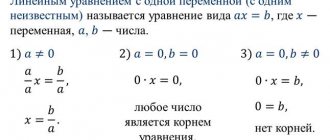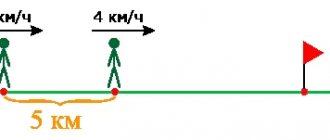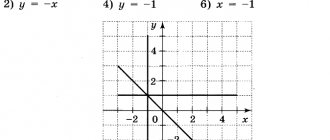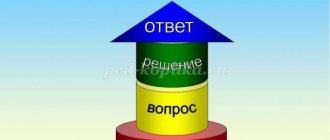Summary of a mathematics lesson in 2nd grade on the topic "Equations"
Summary of a mathematics lesson in 2nd grade (School of Russia) on the topic “Solving equations”
Compiled and conducted by Menshikh T.V. primary school teacher
1. Organizational moment. Self-determination for activity.
- Let's start our math lesson. Let's remember what mathematical operations and exercises we can do? ( Students' answers.
) – Is this enough to complete our knowledge or are there other, unknown to us, tasks?
( Students' answers.
) - Would you like to learn something new?
( Students' answers.
) - I am very pleased to hear this.
There is no point in standing still, getting bored from idleness, we will try all together to learn something new. Important discoveries await all attentive, inquisitive people. Along the road of school knowledge, everyone will be led to success!
This is the motto we will conduct this lesson under. Let's start with oral work.
2. Updating knowledge. Setting a learning task.
– Let’s compare the letter expressions on the board. Let us explain the choice of comparison sign.
a + 3 and a – 3 7– s and 70 – s 17 + c and c + 17 y + 0 and y – 0
–. Let's write down the examples, inserting the missing numbers and getting the correct equalities.
65 + * = 70 * + 20 = 100 34 – * = 31 * – 30 = 10 * + 26 = 56 17 – * = 9
– Check your work and evaluate yourself. (the teacher opens the closed numbers in the examples, the students check their results, rating themselves with “-” and “+” signs)
– Who found a mistake? In what example? Explain the reason for the error. – Who wasn’t mistaken? - Let's complete the following task. Divide the notes on the board into two groups.
19 + * = 21 in – 4 * – 5 = 20 11 + c x + 6 = 14
(The entries are printed on sheets of paper; children divide them into groups “Examples with a window” and “Letter expressions.”)
– How do we work with examples “with a window”? – How do we work with letter expressions? (Students' answers.)
– Have you distributed all the records?
Where did the problem arise? Why are you having trouble? – What does the notation x + 6 = 14 look like? What can you say about her? What can we call it? (In the examples “with a window” we select a number to create a true equality. In literal expressions, we substitute a number instead of a letter and calculate the value of the expression. The entry x + 6 = 14 is similar to both a literal expression and an example with a window. This entry can be called an equality , containing an unknown number.)
- Have you guessed what we will talk about today?
Who knows what such equalities are called in mathematics? (write on the board and in notebooks)
- The topic of our lesson is equation. For the first time today we meet him. And in high school you will solve the most difficult tasks using equations. Even 4000 years ago, mathematicians solved them in Ancient Egypt and Babylon. – What do we need to learn? – And my teacher’s task is to teach you how to work with equations correctly.
3. “Discovery” of new knowledge by children.
– Let’s carry out the assigned tasks. Take a close look at this equation. What needs to be done to solve it? (Find a number instead of x such that the equality is true.)
– Use the selection method to find this number. Prove the correct answer. (This number is 8. since 8 + 6 = 14.)
- What did you do now? (Solved the equation.)
Let's try to draw a conclusion. The equation is ... (teacher shows the “=” sign
), which contains...
(teacher shows x) (students formulate a conclusion).
– What does it mean to solve an equation? (Find a number instead of x such that the equality is true.)
– Compare your conclusion with the conclusion of the textbook on page 68. (Students read the conclusion aloud.)
– The correctness of the equation must be proven. To do this, a check is performed. Today we comment on the test verbally; we find an unknown number using the selection method.
Physical education minute.
I'm happy for you guys! We are lucky today - we know who is masking the unknown number. Meet Mr. X! (Demonstration of a glove puppet.) (The role of Mr. X is played by the teacher.)
Get up from your seat. Hands down. Wider legs, three, four. Raise your hands up - and portray me. Swing left, right. How many X's! Just bravo! Let's sit down together at our desks again, We need to solve problems!
4. Primary consolidation.
– Let’s practice solving equations using the selection method. We perform No. 1 on page 68 of the textbook. We make the first and second columns with comments. (Students write equations at the board and find x by selection.)
– We solve the third and fourth columns independently in pairs, the third column comments on the first option. The fourth column is the second option. (Students work in pairs.)
– We check the completion of the task . (Students comment on the solved equations, confirming the correctness of the answer with their classmates.)
5. Independent work with self-test according to the standard.
– Mr. X comes to you again with a task,
Let's pay attention! “I brought my friends with me. Two numbers familiar to you . (Show cards with numbers 5, 15.)
Together the three of us, take the equations and write them down. Try to come up with different equations. Find X in them - I will listen to all opinions!
(Students independently write equations with the numbers 5 and 15.)
– Check your work. (The teacher opens cards with possible variants of equations.)
–.
Who found it difficult to complete the task? Why? – Who completed all the tasks correctly? (Students' answers.)
6. Inclusion of knowledge and repetition in the system.
– What do we call these entries on the board ? (Equations.)
– Find the extra equation in this column and solve it using the selection method. Justify the choice of equation.
X + 10 = 60 X + 20 = 60 40 + X = 60 X + 30 = 60 X + 40 = 90
(Students verbally prove their choice, then comment on the solution to the equation, confirming the correctness of the answer with their classmates.)
7. Reflection on activity (total lesson).
– What topic did we study in class today? – Let’s remember what tasks we set in the lesson? – Have we completed these tasks? – Evaluate your work in class . (Students' statements.)
– What will those guys who had difficulties working with equations do?
(Students' statements.)
- Let's get ready for the end of the lesson. Let's open the diaries, write down the homework for Friday: page 69 of the textbook, task No. 5, and also make up four of your own equations - two for addition and two for subtraction, find X in them using the selection method. – Our lesson is over. Thank you everyone.
How to teach a child to solve equations
One of the most difficult topics in elementary school is solving equations.
It is complicated by two facts:
Firstly, children do not understand the meaning of the equation. Why was the number replaced with a letter and what is it anyway?
Secondly, the explanation that is offered to children in the school curriculum is in most cases incomprehensible even to an adult:
In order to find the unknown term, you need to subtract the known term from the sum. In order to find an unknown divisor, you need to divide the dividend by the quotient. In order to find the unknown minuend, you need to add the difference to the subtrahend.
And so, when the child comes home, he almost cries.
Parents come to the rescue. And after looking at the textbook, they decide to teach the child to solve “easier.”
You just need to throw the numbers on one side, changing the sign to the opposite, you know?
Look, x-3=7
We transfer minus three with plus to seven, count and get x = 10
This is where the program usually fails for children.
Sign? Change? Postpone? What?
- Mother, father! You don't understand anything! They explained it differently to us at school!!! - Then decide as they explained!
Meanwhile, at school, the topic continues to be trained.
1. First you need to determine which action component you need to find
5+x=17 - you need to find the unknown term. x-3=7 - you need to find the unknown minuend. 10's = 4 - you need to find the unknown subtrahend.
2. Now you need to remember the rule mentioned above
In order to find an unknown term, you need...
Do you think it is difficult for a small student to remember all this?
And we also need to add here the fact that with each class the equations become more and more complex.
As a result, it turns out that equations for children are one of the most difficult mathematics topics in elementary school.
And even if the child is already in the fourth grade, but he has difficulty solving equations, most likely he has a problem understanding the essence of the equation. And we just need to go back to the basics.
You can do this in 2 simple steps:
Step one - We need to teach children to understand equations.
We need a simple mug.
Write an example 3 + 5 = 8
And at the bottom of the mug there is an “x”. And, turning the mug over, cover the number “5”
What's under the mug?
We are sure that the child will guess right away!
Now cover the number "5". What's under the mug?
This way you can write examples for different actions and play. The child understands that x = is not just an incomprehensible sign, but a “hidden number”
Learn more about the technique in the video
Step two - Teach how to determine whether x in an equation is a whole or a part? The biggest or the smallest?
For this we will use the “Apple” technique.
Ask your child the question, where is the largest in this equation?
5+x=17
The child will answer “17.”
Great! This will be our apple!
The largest number is always a whole apple. Let's circle it.
And the whole always consists of parts. Let's underline the parts.
5 and x are parts of an apple.
And since x is a part. Is it bigger or smaller? x big - or small? How to find it?
It is important to note that in this case the child thinks and understands why, in order to find x in this example, you need to subtract 5 from 17.
Smart girl!
Once a child understands that the key to solving equations correctly is determining whether x is a whole or a part, he will find it easy to solve equations.
Because remembering a rule when you understand it is much easier than the other way around: memorize it and learn to apply it.
These “Mug” and “Apple” techniques allow you to teach your child to understand what he is doing and why.
When a child understands a subject, he begins to master it.
When a child succeeds, he likes it.
When you like it, interest, desire and motivation appear.
When motivation appears, the child learns on his own.
Teach your child to understand the program and then the learning process will take up much less time and effort from you.
Did you like the explanation of this topic?
This is exactly how we teach parents to explain the school curriculum at the School of Smart Children, simply and easily.
Do you want to learn how to explain materials to your child in the same accessible and easy way as in this article?
Then register for free for 40 lessons from the school of smart children right now using the button below.
Get 40 lessons from the School of Smart Children for free>>
Did you like the article? Save it to your wall so you don’t lose it
Similar
Lesson summary “Introducing the equation” in mathematics for grade 2
Municipal budgetary educational institution "Gymnasium No. 1"
Math lesson notes in 2nd grade
according to the system of L. V. Zankov
"Introducing the Equation"
prepared by primary school teacher
Ovsyannikova Svetlana Gennadievna
Lesson topic:
Introduction to the equation. Solving equations using the selection method.
Lesson type
: a lesson in children discovering new knowledge.
Target
: introduction of the concept of “equation”, solving the equation by selection method.
Tasks
:
- introduce the concept of “equation”; — promote the development of mathematical speech, logical thinking, and communication abilities; - cultivate attention, the desire to learn “new things”.
Tasks:
1. Formation of positive self-esteem and self-esteem. 2. Formation of communicative competence in cooperation:
- the ability to conduct a dialogue, coordinate your actions with the actions of partners in joint activities;
- formation of socially adequate ways of behavior.
3. Formation of the ability to organize activities and manage them:
- fostering determination and perseverance;
- developing skills in organizing workspace and rational use of working time;
- developing the ability to independently and jointly plan activities and cooperation;
- developing the ability to make decisions independently and jointly.
4. Formation of the ability to solve creative problems. 5. Formation of the ability to work with information (collection, systematization, storage, use).
Lesson on introducing new material
During the classes.
| Formation of UUD | |
| |
Watching a fragment of the cartoon “In the Land of Unlearned Lessons.”
The great country of mathematics is ready to reveal another of its secrets. A secret that will help you learn even more deeply about the laws of this country and make your own discoveries. Care and curiosity will help make you real experts. Well, what's the matter? | Personal UUD • personal, life self-determination; • the action of meaning-making; , “what meaning does the teaching have for me,” and be able to find an answer to it. |
| |
3 + 4 > 5 4 + 2 = 6 4 – 3 5 + 1 = 7 5 + a = 9
What task would you suggest?
Highlight the incorrect equation on the slide. Change one number yourself to get the correct equality. Check with your neighbor to see if your solutions are the same. Who came up with different solutions? Explain how you completed the task. Find other solutions together. Compare with the sample. ( Slide) Are all the entries now correct? | Cognitive UUD • conscious and voluntary construction of a speech utterance; • analysis of objects to identify features Communicative UUD • managing the partner’s behavior - control, correction, evaluation of his actions; Regulatory UUD • control in the form of comparison of the method of action and its result with a given standard in order to detect deviations and differences from the standard; |
| |
| What entry can we not say is true or false? 5 + a = 9 What about this post sounds familiar to you?
Why is this recording unusual for you?
Your observation and ability to work with numbers and numerical expressions brought us closer to a new discovery. Do you know what this record is called? So, we have to find out: (
Look at the following entries. ( Slide ) x + 2 – 4 = 1 9 – c + 2 = 3 + 4 y + 2 = 6 What do they have to do with our equality?
The name of such records is derived from the word “equal”. The equation . How do you understand the meaning of the word “equation”?
What needs to be equalized? Left and right side. What do you think is hidden behind the letter?
Explain what an equation is.
Let's check if we made the right conclusion. Textbook p.72 | • goal setting as setting a learning task based on the correlation of what is already known and learned by the student and what is still unknown; • setting and formulating the problem • independent identification and formulation of a cognitive goal; Cognitive UUD •analysis •understanding the concept based on identifying essential features Regulatory UUD • control in the form of comparison of the method of action and its result with a given standard. |
| |
| How many of you can now recognize the equation and find it among other entries? Find the equation among the entries. ( Slide ) x + 5 > 4 8 – 3 = 5 4 + b > 6 7 + y = 9 9 – z = 3 10 – 6 = 3 + x Prove that you are right. Can we say that we have completed the first task of the lesson?
How can we equalize the left and right sides of the equation?
This is what the guys from No. 176 are trying to do. Which one is right?
Let's check. z + 4 = 7 z = 3 3 + 4 = 7 What does it mean to “solve an equation”?
How did you solve the equation?
Let's solve the written equations using the selection method. 7 + y = 9 9 – z = 3 y = 2 z = 6 7 + 2 = 9 9 – 6 = 3 The third equation is an additional task for those who work forward. 10 – 6 = 3 + x x = 1 10 – 6 = 3 +1 What do you need to know well in order to quickly and correctly solve equations using the selection method?
View the results of the addition table test. Draw a conclusion, evaluate yourself. (Children look at their work, see if there are any errors in them, and draw conclusions.) | Cognitive UUD • proof; • synthesis - composing a whole from parts Regulatory UUD • assessment - the student’s identification and awareness of what has already been learned and what still needs to be learned, awareness of the quality and level of assimilation; Cognitive UUD • reflection on methods and conditions of action, control and evaluation of the process and results of activities |
| |
Physical exercise.
Why was this task difficult?
6 people come to the board, each with 1 card 6 + x = 9 z – 2 = 7 5 + 9 = 14 8 + 1 > 5 – 4 13 – 3 = 10 5 > 1 + 2 | Communicative UUD • planning educational cooperation; • managing the partner’s behavior - control, correction, evaluation of his actions; • the ability to express one’s thoughts with sufficient completeness and accuracy in accordance with the tasks and conditions of communication. Cognitive UUD •classification. |
| |
| Do we have to solve equations in life? Give examples.
| |
| Generalization of what has been learned and its inclusion in the knowledge system. | |
| Write equations using the cards you have. Option 1 has numbers and letters, option 2 has signs. 2 3 5 7 x y + — = Why can't you complete the task? In pairs, write equations and solve them. Remember how to work in pairs correctly. | Communicative UUD • planning educational cooperation; • managing your partner's behavior. Cognitive UUD • synthesis - composing a whole from parts, including independent completion with the completion of missing components; |
| |
What discovery did we make today?
| • reflection on methods and conditions of action, control and evaluation of the process and results of activity; |
List of used literature
1. Ivanov B.A., Petrov V.I. Literature. 10-11 grade. Part 2.- M.: LLC “Education”, 2006
2. Grigoriev M.I. Analysis of a poetic text - M.: “Uchenik”, 2003.
Materials used and Internet resources
1. Video cassette “Culture of Russia. Silver Age", 2006 2. Ivanov I.S. “Great Russia”, CD, 2007 3. Petrov T.I., song “Russia” 4. https://sitename.ru
